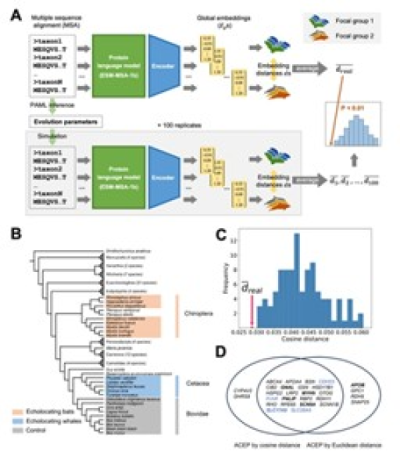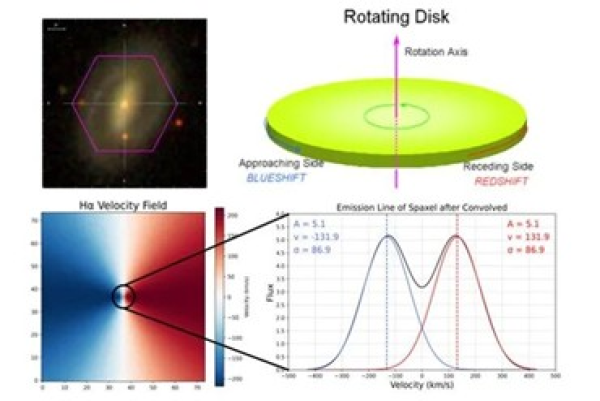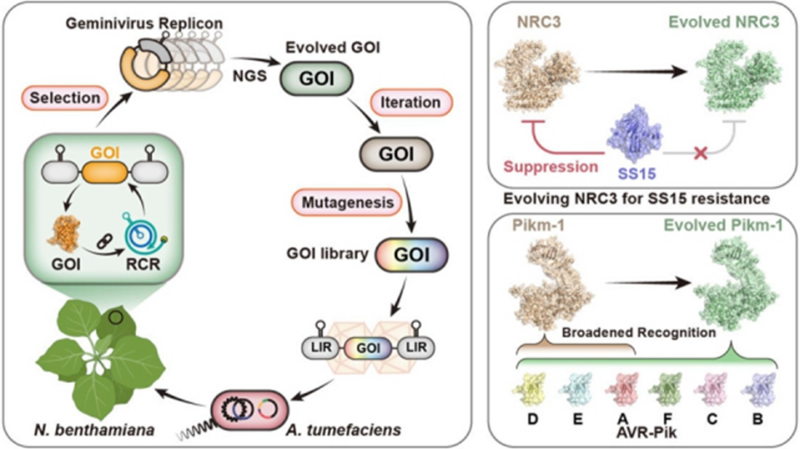Weekly Advanced Technologies〔89〕

Weekly Advanced Technologies〔89〕丨AI Reveals Hidden Evolutionary Patterns: How Unrelated Genes Evolve Identical Functions;The Strange Glow at the Heart of Galaxies: How a Ring and Twin Jets Solve the Puzzle?
Convergent Evolution Beyond Genetics: Superficial biological similarities may not stem from identical genetic mutations. A groundbreaking study reveals that deep structural convergence in proteins could be a hidden evolutionary cipher. Meanwhile, apparent spectral signatures of binary black holes might merely be artifacts created by galactic 'halos.' A research team from the Chinese Academy of Sciences uncovered a novel physical mechanism, fundamentally reshaping our understanding of galactic nuclei.
Based on the weekly diary of technology provided by the daily list of the NCSTI online service platform, we launch the column "Weekly Advanced Technologies" at the hotlist of sci-tech innovation. Today, let's check out No.89.
1. PNAS丨AI Reveals Hidden Evolutionary Patterns: How Unrelated Genes Evolve Identical Functions

Schematic diagram of ACEP pipeline and candidate sensory perception-related adaptive convergent genes identified in echolocating mammals
The research team led by Zou Zhengting at the Institute of Zoology, Chinese Academy of Sciences has developed ACEP (Adaptive Convergence Evolutionary Profiler), a novel computational framework employing AI to reveal a 'high-order feature convergence' mechanism in proteins. While traditional views attribute functional convergence to independent mutations at identical amino acid sites (site-specific convergence), many functionally analogous proteins lack such variations - a longstanding enigma.
The study innovatively applies pre-trained protein language models to transform sequences into evolution-informed high-dimensional embeddings, capturing supra-site structural and physicochemical patterns. Strikingly, functionally similar proteins exhibited significantly closer distances in embedding space even without apparent site convergence, demonstrating higher-order feature convergence.
Building upon this, the team developed the ACEP pipeline: (1) Calculating true embedding distances of homologous proteins, (2) Constructing background distributions via simulated neutral evolution, (3) Performing statistical tests to identify significant high-order convergence signals.
This method successfully detected signals in multiple known convergence cases. Genome-wide screening revealed hundreds of genes exhibiting such signals between bats and toothed whales, with significant enrichment in "sensory perception" and related functions—including known echolocation-related genes and novel candidates, some of which passed positive selection tests. Further analysis decoded the physicochemical features underlying embedding convergence, enhancing interpretability.
The study demonstrates the critical role of protein high-order features in adaptive evolution and highlights AI's potential in deciphering complex genotype-phenotype relationships. The ACEP framework is openly available on HuggingFace, providing a new tool for genome-wide exploration of convergent evolution.
2. The Astrophysical Journal丨The Strange Glow at the Heart of Galaxies: How a Ring and Twin Jets Solve the Puzzle?

The mechanism of double-peaked narrow emission lines in the 'Dotating disk + Circumnuclear ring' model
The Shanghai Astronomical Observatory research team has conducted an in-depth investigation into the origin of double-peaked narrow emission lines in galactic nuclei using MaNGA integral field spectroscopy data from the Sloan Digital Sky Survey. While such spectral features were historically considered key evidence for binary supermassive black holes, subsequent studies reveal that mechanisms like rapidly rotating gas disks or AGN-driven outflows can produce analogous signatures.
In this study, the research team focuses on barred spiral galaxies and proposes the 'Disk+Circumnuclear Ring' model as a novel mechanism for generating symmetric double-peaked narrow emission lines. The galactic bar drives gas inflow, accumulating at the inner Lindblad resonance (ILR) to form a compact yet luminous nuclear ring. This ring resides precisely within the steepest gradient of the galaxy's rotation curve, where gas on opposite sides exhibits stark velocity contrasts: blueshifted for the approaching side and redshifted for the receding side. Due to the limited spatial resolution of telescopes (PSF effects), the central pixels spectroscopically blend emissions from both sides, resulting in the observed symmetric double-peaked profiles.
By combining MaNGA's spatially resolved spectroscopy with a simplified rotating disk model, this study confirms that the ordered, symmetric rotation of the nuclear ring produces spatially coherent double-peaked emission features. This has provided a novel physical interpretation for double-peaked narrow lines, definitively demonstrating that such features are not exclusive signatures of binary supermassive black holes (SMBHs). The results has advanced our understanding of galactic nuclear structure and dynamics, while establishing critical criteria for identifying genuine dual-AGN candidates – crucially requiring higher-resolution follow-ups or multi-wavelength verification.
3. Nature Microbiology丨Why Ticks Make Us Sick? Groundbreaking Study Maps Nature vs. Nurture in Disease Vectors
The research team led by ZHAO Fangqing from the Institute of Zoology, Chinese Academy of Sciences, in collaboration with teams headed by CAO Wuchun & JIA Na from the Academy of Military Medical Sciences, and WANG Jinfeng from China Agricultural University, has conducted the largest-scale tick microbiome study to date. The consortium collected over 16,000 tick samples spanning 48 species across 8 genera from all 31 provincial-level regions in mainland China. By integrating second- and third-generation sequencing technologies, they systematically decoded tick genomic characteristics, microbiome composition, and pathogen distribution patterns.
Through in-depth genomic analysis, the study obtained 7,783 metagenome-assembled genomes (MAGs) of medium-to-high quality, among which 1,373 representative genomes were selected. Approximately two-thirds of these represent undefined species, highlighting the complexity of tick microbiomes. The analysis revealed that tick microbial composition exhibits significant species-specific and geographic-specific patterns. Five distinct microbiome ecotypes dominated by different bacterial taxa were identified, whose distributions are strongly influenced by environmental factors such as temperature and humidity. Notably, these ecotypes respond to similar environmental drivers.
Further analysis revealed that the Rickettsia-dominated ecotype is strongly associated with specific tick species and free-living populations in Northeast China and the Inner Mongolia–Xinjiang regions, indicating lifestyle plays a pivotal role in microbiome assembly. Random forest modeling confirmed that tick species and host animals are key determinants of microbiome composition. The study also uncovered correlations between tick mitochondrial genome diversity and microbiome similarity. Through microbiome-wide association studies (mGWAS), multiple SNPs significantly linked to pathogen abundance were identified in Haemaphysalis longicornis, Rhipicephalus microplus, and Dermacentor silvarum. These loci involve critical genes related to peptidase activity, neural signaling, and hormonal metabolism.
The research team has constructed a nationwide 'Tick-Microbe-Environment' database, which has revealed the association mechanisms among genotypes, environmental factors, and pathogen transmission. This work has provided crucial scientific foundations for the surveillance, early warning, and precision control of tick-borne diseases.
4. Science丨Autonomous Gene Optimization Frameworks in Plant Tissues

The schematic and applications of Geminivirus Replicon-Assisted in Planta Directed Evolution (GRAPE)
Prof. GAO Caixia’s team from the Institute of Genetics and Developmental Biology, Chinese Academy of Sciences, in collaboration with Prof. QIU Jinlong’s team from the Institute of Microbiology, HAS DEVELOPED the first highly efficient and universal in Geminivirus Replicon-Assisted in Planta Directed Evolution, GRAPE. This breakthrough has filled a long-standing gap in plant biology by establishing the first in vivo directed evolution tool, providing a revolutionary technological platform for high-yield and stress-resistant crop breeding.
The system is based on engineered geminiviral replicons, enabling rapid and high-throughput directed evolution of target genes in living plants. Using the GRAPE system, the research team achieved screening of up to 100,000 genetic variants on a single Nicotiana benthamiana leaf within just four days, dramatically improving gene optimization efficiency. Since the entire evolutionary process occurs in planta, the selected superior variants require no additional adaptive optimization and can be directly applied to breeding or functional studies, significantly shortening the R&D cycle."
"The team has demonstrated the system's power by successfully implementing in vivo directed evolution of plant immune receptors NRC3 and Pikm-1, validating its potential to enhance disease resistance. GRAPE overcomes the limitations of traditional in vitro evolution—which relies on complex transformation and functional validation—by integrating 'evolution-screening-application' into a seamless workflow.
This technology has provided a powerful tool for plant gene functional studies and protein engineering, while also opening up new pathways to accelerate molecular breeding and synthetic biology development. Reviewers have recognized that this achievement has filled a critical technological gap and is poised to exert far-reaching impacts on plant science and agricultural biotechnology.